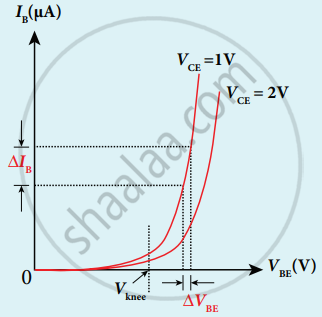Advertisements
Advertisements
Question
Sketch the static characteristics of a common emitter transistor and bring out the essential features of input and output characteristics.
Solution

Static characteristics of a NPN transistor in common emitter configuration
- The circuit to study the static characteristics of NPN transistor is given in figure
- Bias supply voltages VBB and VCC bias, base-emitter junction and collector-emitter junction.
- Junction potentials are VBE and YCE
- R1 and R2 are used to vary base and collector currents respectively.
1. Input Characteristics:

- Input Characteristics curve gives the relationship between IB and VBE at constant VCE
- For constant collector-emitter voltage VCE, Base emitter voltage VBE increases for corresponding Base current IB which is recorded and graph is ploted.
- The curve looks like forwarding characteristics.
- Beyond knee voltage base current increases with an increase in base-emitter voltage for silicon 0.7 V and for Germanium 0.3 V.
- Increase in VCE decreases IB. This shifts the curves outward.
- Input resistance Ri = `((Δ"V"_"BE")/(Δ"I"_"B"))_("V"_"CE")`
2. Output characteristics:

- The output characteristics give the relation between ∆IC with respect to ∆VCE at constant IB
- Initially base current IB is set to a particular value. Increasing collector-emitter voltage VCE corresponding collector current IC increases. A graph is plotted.
- Output resistance Ro = `((Δ"V"_"CE")/(Δ"I"_"C"))_"IB"`
The four important regions in the output characteristics are:
- Saturation region: When VCE increased above 0V, IC increases rapidly almost independent of IB called knee voltage Transistor operated above this knee voltage.
- Cut-off region: A small IC exists even after IB is reduced to zero. This current is due to the presence of minority carriers across the collector-base junction and the surface leakage current (ICEO). This region is called the cut-off region.
- Active region: In this region emitter-base junction is forward bias, collector-base junction is reverse bias. Transistors in this region can be used for voltage, current and power amplification.
- breakdown region: If VCE is increased beyond rated value, given Ic increases enormously leading to junction breakdown of the transistor. This avalanche breakdown can damage.
APPEARS IN
RELATED QUESTIONS
The common-base DC current gain of a transistor is 0.967. If the emitter current is 10mA. What is the value of base current?
Derive the relation between α and β.
Transistor functions as a switch. Explain.
For a transistor, the current ratio 'βdc' is defined as the ratio of ______.
In the symbol for a transistor, the arrow head points in the direction of the ____________.
In case of npn transistors, the collector current is always less than the emitter current because ______.
For a common emitter configuration, if 'α' and 'β' have their usual meanings, the correct relationship between 'α' and 'β' is ______.
In a silicon transistor, a change of 7.89 mA in the emitter current if produces a change of 7.8 mA in the collector current, then the base current must change by ____________.
The current gain `alpha` of a transistor is 0.95. The change in collector current corresponding to a change of 0.4 mA in the base current in a common emitter arrangement is ______.
In common emitter amplifier, a change of 0.2 mA in the base current causes a change of 5 mA in the collector current. If input resistance is 2K `Omega` and voltage gain is 75, the load resistance used in the circuit is ______.
